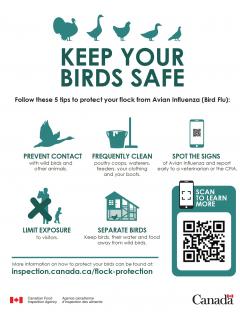Avian Influenza (AI)
AI is a viral disease that can affect the respiratory, enteric (digestive) or nervous system of many kinds of poultry and other birds. Clinical signs of AI are variable and depend on factors such as strain of the virus, the pathogenicity (disease-producing capability) of the virus, host species, age, sex, environmental conditions (poor environmental conditions worsen the disease) and presence of concurrent infections. Clinical signs of Highly Pathogenic Avian Influenza (HPAI) in chickens and turkeys depend on the organs and tissues affected by the virus. Please note that not all clinical signs are seen in every bird.
The current outbreak of Avian Influenza is caused by a highly pathogenic strain of influenza, H5N1.
Some or all the following clinical signs of HPAI may be seen in infected birds:
- a drop in production of eggs, many of which are soft-shelled or shell-less
- diarrhea
- haemorrhages on the hock
- high and sudden mortality rate
- quietness and extreme depression
- swelling of the skin under the eyes
- wattles and combs become swollen and congested
- respiratory signs such as sneezing and coughing
- nervous signs such as tremors of the head and neck, or an inability to stand
The incubation period of AI ranges from 2 to 14 days.
Transmission and spread of AI Virus
All avian (bird) species are susceptible to infection by the AI virus. However, wild birds, especially waterfowl, are natural reservoirs of influenza viruses and are considered to be crucial to the spread of the virus. Since they can carry the virus without any signs of illness, they are considered the major reservoir for AI infections in domestic poultry. Small flocks in Atlantic Canada that have been infected with this virus have commonly had watercourses on their property. It is essential that you do not allow your domestic birds to co-mingle with wild waterfowl.
The disease can spread to birds through contact with infected poultry and poultry products. It can also spread through contaminated manure, litter, clothing, footwear, vehicles, equipment, feed, and water.
It is essential for commercial poultry producers to use strict biosecurity practices in order to prevent introduction of the virus to their flock. Farmers should take the following measures:
- Keep poultry away from areas frequented by wild birds.
- Maintains strict control over access to poultry houses.
- Make sure that equipment is cleaned and disinfected before taking it into poultry houses.
- Do not keep bird feeders or create duck ponds close to poultry barns because they attract wild birds.
- Maintain high sanitation standards.
Co-mingling of birds from different sources, fecal material of crates and vehicles and purchase of birds with unknown AI status all contribute to the chance that the virus will be carried to the home farm..
Keep Your Birds Safe poster
Click the image to download a copy of the "Keep Your Birds Safe" poster
(PDF file includes English and French posters)
Avian influenza viruses, such as the currently circulating highly pathogenic H5N1 virus, can, on rare occasions, cause disease in humans.
Transmission to humans has occurred when people have had close contact with infected birds or heavily contaminated environments. Report any disease suspicion in your flock to a veterinarian without delay.
The currently circulating HPAI H5N1 virus has infected a number of other species besides birds. Most recently, on March 25, 2024, H5N1 Influenza virus was detected in Kansas and Texas dairy herds. Since the initial detections, H5N1 has also been confirmed in herds in several other states. Affected cows show clinical signs that include a decrease in milk production and thicker consistency milk. The animals appear to recover after a period of illness, and it is suspected that wild birds may have initially introduced the virus with spread now suspected to include mechanical (i.e. milking machine) bovine-to-bovine transmission.
There has been one human detection connected to an affected herd and the person’s only symptom was conjunctivitis.
The Canadian Food Inspection Agency (CFIA) has not detected highly pathogenic avian influenza (HPAI) in dairy cattle or other livestock in Canada and are monitoring the situation closely. Contact your veterinarian immediately if you have disease suspicions in your cattle or other livestock.
The risk of HPAI transmission to humans remains low.
The latest Canadian information can be found on CFIA’s website.
For more information:
Please refer to the Canadian Food Inspection Agency's Factsheet: Avian Influenza
- For up to date information on domestic bird infections across Canada, visit CFIA's Status of ongoing avian influenza response by province website.
- For up to date information on wild bird infections, visit CFIA's National Avian Influenza dashboard
- For up-to-date information on Influenza A in cattle
- For up-to-date guidance information for private veterinarians on Influenza A in cattle
